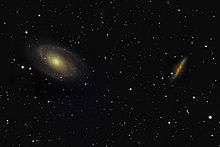Messier 81
Messier 81 (also known as NGC 3031 or Bode's Galaxy) is a grand design spiral galaxy about 12 million light-years away, with a diameter of 90,000 light years, about half the size of the Milky Way, in the constellation Ursa Major. Due to its proximity to Earth, large size, and active galactic nucleus (which harbors a 70 million M☉[5] supermassive black hole), Messier 81 has been studied extensively by professional astronomers. The galaxy's large size and relatively high brightness also makes it a popular target for amateur astronomers.[6]
| Messier 81 | |
|---|---|
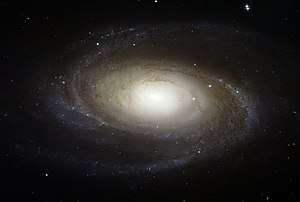 The HST's view of M81, with its open star clusters, globular star clusters, and regions of fluorescent gas. | |
| Observation data (J2000 epoch) | |
| Constellation | Ursa Major[1] |
| Right ascension | 09h 55m 33.2s[2] |
| Declination | +69° 3′ 55″[2] |
| Redshift | −0.000113 |
| Helio radial velocity | −34 |
| Galactocentric velocity | 73 |
| Apparent magnitude (V) | 6.94[3][4] |
| Characteristics | |
| Type | SA(s)ab,[2] LINER[2] |
| Apparent size (V) | 26.9 × 14.1 moa[2] |
| Other designations | |
| NGC 3031, UGC 5318, MCG+12-10-010, PGC 28630, Bode's Galaxy[3] | |
Discovery
Messier 81 was first discovered by Johann Elert Bode on 31 December 1774.[7] Consequently, the galaxy is sometimes referred to as "Bode's Galaxy". In 1779, Pierre Méchain and Charles Messier reidentified Bode's object, which was subsequently listed in the Messier Catalogue.[7] Messier 81 is located approximately 10° northwest of Alpha Ursae Majoris along with several other galaxies in the Messier 81 Group.[6][8]
Visibility
Messier 81 and Messier 82 can both be viewed easily using binoculars and small telescopes.[6][8] The two objects are generally not observable to the unaided eye, although highly experienced amateur astronomers may be able to see Messier 81 under exceptional observing conditions with a very dark sky.[6] Telescopes with apertures of 8 inches (20 cm) or larger are needed to distinguish structures in the galaxy.[8] Its far northern declination makes it generally visible for observers in the northern hemisphere. It is not visible to most observers in the southern hemisphere, except those in a narrow latitude range immediately south of the equator.
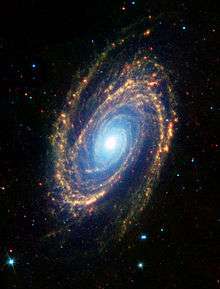
Interstellar dust
Most of the emission at infrared wavelengths originates from interstellar dust.[10][11] This interstellar dust is found primarily within the galaxy's spiral arms, and it has been shown to be associated with star formation regions.[10][11] The general explanation is that the hot, short-lived blue stars that are found within star formation regions are very effective at heating the dust and thus enhancing the infrared dust emission from these regions.
Globular clusters
It is estimated M81 has 210 ± 30 globular clusters.[12]
Supernovae
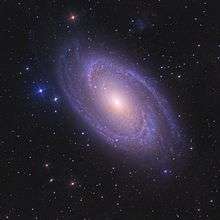
Only one supernova has been detected in Messier 81.[13] The supernova, named SN 1993J, was discovered on 28 March 1993 by F. García in Spain.[14] At the time, it was the second brightest supernova observed in the 20th century.[15] The spectral characteristics of the supernova changed over time. Initially, it looked more like a type II supernova (a supernova formed by the explosion of a giant star) with strong hydrogen spectral line emission, but later the hydrogen lines faded and strong helium spectral lines appeared, making the supernova look more like a type Ib.[15][16]
Moreover, the variations in SN 1993J's luminosity over time were not like the variations observed in other type II supernovae,[17][18] but did resemble the variations observed in type Ib supernovae.[19] Hence, the supernova has been classified as a type IIb, a transitory class between type II and type Ib.[16] The scientific results from this supernova suggested that type Ib and Ic supernovae were formed through the explosions of giant stars through processes similar to those taking place in type II supernovae.[16][20] Despite the uncertainties in modeling the unusual supernova, it was also used to estimate a very approximate distance of 8.5 ± 1.3 Mly (2.6 ± 0.4 Mpc) to Messier 81.[15] As a local galaxy, the Central Bureau for Astronomical Telegrams (CBAT) tracks novae in M81 along with M31 and M33.[21]
Environment
Messier 81 is the largest galaxy in the M81 Group, a group of 34 galaxies located in the constellation Ursa Major.[22] At approximately 11.7 Mly (3.6 Mpc) from the Earth, it makes this group and the Local Group, containing the Milky Way,[22] relative neighbors in the Virgo Supercluster.
Gravitational interactions of M81 with M82 and NGC 3077[23] have stripped hydrogen gas away from all three galaxies, forming gaseous filamentary structures in the group.[23] Moreover, these interactions have allowed interstellar gas to fall into the centers of M82 and NGC 3077, leading to vigorous star formation or starburst activity there.[23]
See also
- List of galaxies
- List of Messier objects
- M81 in fiction (in the galaxies in fiction article)
- Messier object
- New General Catalogue
Gallery
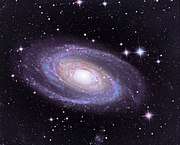 M81, Bode's Galaxy. LRGBHa Image by W4SM with 17" PlaneWave CDK.
M81, Bode's Galaxy. LRGBHa Image by W4SM with 17" PlaneWave CDK.
References
- Dreyer, J. L. E. (1988). Sinnott, R. W. (ed.). The Complete New General Catalogue and Index Catalogue of Nebulae and Star Clusters. Sky Publishing Corporation / Cambridge University Press. ISBN 978-0-933346-51-2.
- "NASA/IPAC Extragalactic Database". Results for NGC 3031. Retrieved 10 November 2006.
- "M 81". SIMBAD. Centre de données astronomiques de Strasbourg. Retrieved 28 November 2009.
- Armando, Gil de Paz; Boissier, Samuel; Madore, Barry F.; Seibert, Mark; Joe, Young H.; Boselli, Alessandro; Wyder, Ted K.; Thilker, David; Bianchi, Luciana; Rey, Soo-Chang; Rich, R. Michael; Barlow, Tom A.; Conrow, Tim; Forster, Karl; Friedman, Peter G.; Martin, D. Christopher; Morrissey, Patrick; Neff, Susan G.; Schiminovich, David; Small, Todd; Donas, José; Heckman, Timothy M.; Lee, Young-Wook; Milliard, Bruno; Szalay, Alex S.; Yi, Sukyoung (2007). "The GALEX Ultraviolet Atlas of Nearby Galaxies". Astrophysical Journal. 173 (2): 185–255. arXiv:astro-ph/0606440. Bibcode:2007ApJS..173..185G. doi:10.1086/516636.
- Devereux, N.; Ford, H.; Tsvetanov, Z.; Jocoby, J. (2003). "STIS Spectroscopy of the Central 10 Parsecs of M81: Evidence for a Massive Black Hole". Astronomical Journal. 125 (3): 1226–1235. Bibcode:2003AJ....125.1226D. doi:10.1086/367595.
- O'Meara, S. J. (1998). The Messier Objects. Cambridge University Press. ISBN 978-0-521-55332-2.
- Jones, K. G. (1991). Messier's Nebulae and Star Clusters (2nd ed.). Cambridge University Press. ISBN 978-0-521-37079-0.
- Eicher, D. J. (1988). The Universe from Your Backyard. Cambridge University Press. ISBN 978-0-521-36299-3.
- Willner, S. P.; Ashby, M. L. N.; Barmby, P.; Fazio, G. G.; Pahre, M.; Smith, H. A.; Kennicutt Jr., R. C.; Calzetti, D.; Dale, D. A.; Draine, B. T.; Regan, M. W.; Malhotra, S.; Thornley, M. D.; Appleton, P. N.; Frayer, D.; Helou, G.; Stolovy, S.; Storrie-Lombardi, L. (2004). "Infrared Array Camera (IRAC) Observations of M81". Astrophysical Journal Supplement Series. 154 (1): 222–228. arXiv:astro-ph/0405626. Bibcode:2004ApJS..154..222W. doi:10.1086/422913.
- Gordon, K. D.; Pérez-González, P. G.; Misselt, K. A.; Murphy, E. J.; Bendo, G. J.; Walter, F.; Thornley, M. D.; Kennicutt Jr., R. C.; Rieke, G. H.; Engelbracht, C. W.; Smith, J.-D. T.; Alonso-Herrero, A.; Appleton, P. N.; Calzetti, D.; Dale, D. A.; Draine, B. T.; Frayer, D. T.; Helou, G.; Hinz, J. L.; Hines, D. C.; Kelly, D. M.; Morrison, J. E.; Muzerolle, J.; Regan, M. W.; Stansberry, J. A.; Stolovy, S. R.; Storrie-Lombardi, L. J.; Su, K. Y. L.; Young, E. T. (2004). "Spatially Resolved Ultraviolet, Hα, Infrared, and Radio Star Formation in M81". Astrophysical Journal Supplement Series. 154 (1): 215–221. arXiv:astro-ph/0406064. Bibcode:2004ApJS..154..215G. doi:10.1086/422714.
- Pérez-González, P. G.; Kennicutt Jr., R. C.; Gordon, K. D.; Misselt, K. A.; Gil De Paz, A.; Engelbracht, C. W.; Rieke, G. H.; Bendo, G. J.; Bianchi, L.; Boissier, S.; Calzetti, D.; Dale, D. A.; Draine, B. T.; Jarrett, T. H.; Hollenbach, D.; Prescott, M. K. M. (2006). "Ultraviolet through Far-Infrared Spatially Resolved Analysis of the Recent Star Formation in M81 (NGC 3031)". Astrophysical Journal. 648 (2): 987–1006. arXiv:astro-ph/0605605. Bibcode:2006ApJ...648..987P. doi:10.1086/506196.
- Chandar, Rupali; Whitmore, Bradley; Lee, Myung Gyoon (10 August 2004). "The Globular Cluster Systems of Five Nearby Spiral Galaxies: New Insights fromHubble Space TelescopeImaging". The Astrophysical Journal. 611 (1): 220–244. doi:10.1086/421934. ISSN 0004-637X.
- "NASA/IPAC Extragalactic Database". Results for extended name search on NGC 3031. Retrieved 27 February 2007.
- Ripero, J.; Garcia, F.; Rodriguez, D.; Pujol, P.; Filippenko, A. V.; Treffers, R. R.; Paik, Y.; Davis, M.; Schlegel, D.; Hartwick, F. D. A.; Balam, D. D.; Zurek, D.; Robb, R. M.; Garnavich, P.; Hong, B. A. (1993). "Supernova 1993J in NGC 3031". IAU Circular. 5731: 1. Bibcode:1993IAUC.5731....1R.
- Schmidt, B.P.; Kirshner, R.P.; Eastman, R.G.; Grashuis, R.; Dell'Antonio, I.; Caldwell, N.; Foltz, C.; Huchra, John P.; Milone, Alejandra A. E. (1993). "The unusual supernova SN1993J in the galaxy M81". Nature. 364 (6438): 600–602. Bibcode:1993Natur.364..600S. doi:10.1038/364600a0.
- Filippenko, A. V.; Matheson, T.; Ho, L. C. (1993). "The "Type IIb" Supernova 1993J in M81: A Close Relative of Type Ib Supernovae". Astrophysical Journal Letters. 415: L103–L106. Bibcode:1993ApJ...415L.103F. doi:10.1086/187043.
- Benson, P. J.; Herbst, W.; Salzer, J. J.; Vinton, G.; Hanson, G. J.; Ratcliff, S. J.; Winkler, P. F.; Elmegreen, D. M.; Chromey, F.; Strom, C.; Balonek, T. J.; Elmegreen, B. G. (1994). "Light curves of SN 1993J from the Keck Northeast Astronomy Consortium". Astronomical Journal. 107: 1453–1460. Bibcode:1994AJ....107.1453B. doi:10.1086/116958.
- Wheeler, J. C.; Barker, E.; Benjamin, R.; Boisseau, J.; Clocchiatti, A.; De Vaucouleurs, G.; Gaffney, N.; Harkness, R. P.; Khokhlov, A. M.; Lester, D. F.; Smith, B. J.; Smith, V. V.; Tomkin, J. (1993). "Early Observations of SN 1993J in M81 at McDonald Observatory". Astrophysical Journal. 417: L71–L74. Bibcode:1993ApJ...417L..71W. doi:10.1086/187097.
- Richmond, M. W.; Treffers, R. R.; Filippenko, A. V.; Palik, Y.; Leibundgut, B.; Schulman, E.; Cox, C. V. (1994). "UBVRI photometry of SN 1993J in M81: The first 120 days". Astronomical Journal. 107: 1022–1040. Bibcode:1994AJ....107.1022R. doi:10.1086/116915.
- Filippenko, A. V.; Matheson, T.; Barth, A. J. (1994). "The peculiar type II supernova 1993J in M81: Transition to the nebular phase". Astronomical Journal. 108: 2220–2225. Bibcode:1994AJ....108.2220F. doi:10.1086/117234.
- Bishop, David. "Extragalactic Novae". supernovae.net (International Supernovae Network). Archived from the original on 8 April 2010. Retrieved 11 September 2010.
- Karachentsev, I. D. (2005). "The Local Group and Other Neighboring Galaxy Groups". Astronomical Journal. 129 (1): 178–188. arXiv:astro-ph/0410065. Bibcode:2005AJ....129..178K. doi:10.1086/426368.
- Yun, M. S.; Ho, P. T. P.; Lo, K. Y. (1994). "A high-resolution image of atomic hydrogen in the M81 group of galaxies". Nature. 372 (6506): 530–532. Bibcode:1994Natur.372..530Y. doi:10.1038/372530a0. PMID 7990925.
External links
| Wikimedia Commons has media related to Messier 81. |
- StarDate: M81 Fact Sheet
- M81, SEDS Messier pages
- SST: Messier 81
- NASA Astronomy Picture of the Day: Bright Galaxy M81 (20 June 2002)
- NightSkyInfo.com – M81, Bode's Galaxy
- Messier 81 on WikiSky: DSS2, SDSS, GALEX, IRAS, Hydrogen α, X-Ray, Astrophoto, Sky Map, Articles and images
- ESA/Hubble images of M81
- Galaxy Messier 81 (Bode's Galaxy)
- Spitzer Image Gallery
- Helkit Observatory
- Deep image of the M81 Area
- Bode's Galaxy at Constellation Guide
